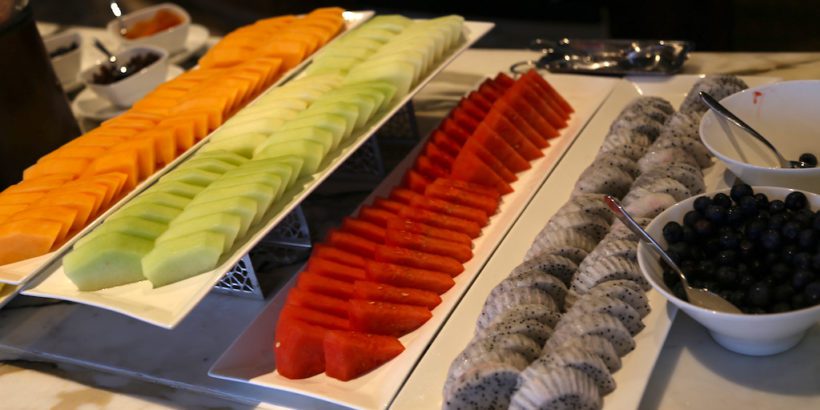A lot of people are shocked to find out that they can bring all types of food on a plane without any problem with TSA.
But when you’re bringing fruits, especially fresh fruits, you can run into more issues depending on where you are departing and arriving.
In this article, will try to slice through the confusion to give you a fresh perspective on traveling with fruit on a plane.
Table of Contents
Can you bring fruit on a plane?
You can bring fruit on a domestic flight within the mainland US without any issues in the vast majority of cases.
However, if you were flying between the mainland and states or territories like Hawaii or Puerto Rico, you will need to declare your fruit and ensure that they pass inspection.
In addition, if you are flying internationally you need to make sure your fruit is allowed and that it passes inspection after you declare it.
Tip: Use the free app WalletFlo to help you travel the world for free by finding the best travel credit cards and promotions!
Why is bringing fruit such a problem?
The main reason why countries and states want to control what fruit makes its way through their airports is to prevent outbreaks of destructive pests.
Unfortunately, invasive pests are known to live in many different types of fruits.
What type of pests are we talking about?
There are quite a few to worry about including things like certain maggots, weevils, and curculio, but the big one is the fruit fly.
These come in different varieties like the Caribbean Fruit Fly and the Mexican Fruit Fly
All of these invasive pests can be a real danger to agriculture.
Not only can the ecosystem take a major hit but losses could be catastrophic for farmers and ranchers — not to mention all of the laborers which might depend on a specific fruit like bananas to make a living. We are talking billions of dollars.
The effects of a major outbreak event could ripple well downstream and could mean higher grocery bills along with food shortages.
Even with protocols in place, sometimes these pests still find a way to make it in.
For example, in 2015 an American Mediterranean fruit fly was detected in Puerto Rico, capable of causing damage to tomato, mango, avocado, coffee, papaya and cantaloupe.
So travelers should really take these regulations seriously so that they don’t bring about an environmental disaster.
What you need to know about bringing fruit on a plane
Below, I’ll talk about some specific rules and regulations for bringing fruit when traveling by aircraft to various locations.
But before we get into the nitty-gritty, here are a few general rules you can expect to encounter when trying to bring fruit on a plane.
Domestic travel on the mainland US
If you’re hopping from one mainland state to another or traveling within one state on the mainland, you will not have to declare your fruit.
What’s more, TSA will allow you to bring fruit in your checked bag or carry-on.
You must declare for certain regions
If you are bringing fruit from the US to a sensitive region or vice versa you will have to declare that fruit.
The fruit will then have to pass an inspection and you will be checked for any necessary permits (if needed).
Typically, the way it works is that there are some types of fruits that you can bring in but only after they have been inspected.
Then there are certain types of fruit that are never allowed.
It will be up to you to make sure you have reviewed the latest guidelines for whatever destination you are arriving in.
Canned fruits are usually okay
Commercially canned fruits are rarely ever a problem although sometimes you need to show the country of origin, so it helps if you maintain the packaging and keep your receipts.
Frozen fruit is sometimes okay
Frozen fruit is allowed sometimes but other times it is not, such as when arriving into the US from an international flight. You might run into nuanced rules like “no frozen mangoes with seeds” so keep that in mind.
Related: How to (Legally) Bring Pineapples From Hawaii to the Mainland

Travel between the US and sensitive regions
You really need to pay attention to fruit rules when you travel between the mainland of the US and “sensitive” regions such as Hawaii and Puerto Rico.
The restrictions apply both when you are leaving the mainland and coming back.
To get a sense of what you can expect when flying to the mainland from certain sensitive regions let’s dive into the regulations for Puerto Rico and Hawaii.
First, when traveling from Puerto Rico to the mainland you can bring in fruit items like:
- Cantelope
- Cannonball fruit
- Bananas
- Grapefruit
- Orange
- Lemon
- Lime
- Papaya
- Pineapple
- Strawberry
- Watermelon
Those are just a few of the permitted fruit items.
As for what fruits are not allowed, this just includes things not found on that list.
So often you just have to perform a search on a given USDA page or PDF to see if you can find your desired fruit. Usually, if a fruit is allowed it will be explicitly mentioned.
And don’t think that because Puerto Rico is a US territory that you don’t have to declare your items. You still do.
In fact, if you fail to declare that could result in civil penalties ranging from $100 to $1,000 per violation.
You’ll also find similar restrictions on traveling from Hawaii to the mainland.

From the Mainland
Now let’s that say you were traveling from the mainland to somewhere like Hawaii.
When you are departing from the mainland, TSA states:
Passengers flying from Hawaii, Puerto Rico, or the U.S. Virgin Islands to the U.S. mainland cannot take most fresh fruits and vegetables due to the risk of spreading invasive plant pests.
TSA does not offer much detail which is understandable because this is not their domain so once again we have to check with the USDA.
Hawaii allows most plants into the state but only after an inspection.
It’s also worth noting that some fruits will have to have a permit and/or quarantine, treatments, or certification.
These include the following:
- Pineapple and bromeliad plants and fruits
- Passion fruit plants and seeds
- Citrus and pulpy fruits from Florida & Puerto Rico
- Coconuts
In general, foods that are cooked, canned, frozen or commercially processed and/or packaged are allowed to be transported to Hawaii, as long as the product is arriving from within the U.S.

Traveling within the mainland
When traveling within the mainland you may also have to be mindful of specific regulations that certain states have. For example, the California Department of Food and Agriculture (CDFA) provides specific guidelines on bringing fruits and vegetables into California.
You might be surprised how specific some of these restrictions are and what the conditions of entry might be.
For example, you may have to get certain items inspected if you are bringing in an item from a restricted state. There may even be restrictions applying to specific counties within a state.
You won’t find CDFA checkpoints at airports like you will when entering in through land borders but you will still be expected to comply with these regulations so you should be aware of them.
Traveling internationally
The rules get tighter when you travel with fruit on an international route. Let’s take a look at some of the key rules for traveling with fruit into the US.
The general rule for fresh fruits
The vast majority of fresh fruits are prohibited from entering the United States.
Something to be aware of on a plane is that this rule applies to fresh fruits you might be given on the airplane.
For example, it’s common for first class and business class flights to provide you with fresh fruit especially towards the end of your flight.
You’ll have to make sure to throw those out before you head through customs.

Canned fruits
For the most part, commercially canned fruits are allowed to be brought into the US as long as you declare them.
Just be aware that Customs will not allow home-canned products due to the lack of standards in canning practices.
Frozen fruits
Most frozen fruits are prohibited from entering the US.
This is apparently because some tests and diseases can survive even in cold temperatures. This is a departure from the rule going to Hawaii so it’s a notable difference to remember.
Dried fruits
Most dried fruits will not be allowed in the US unless you have met special requirements.
Always remember to declare!
If you are coming into the US, you will have to declare all agriculture products, including fruit.
They would then need to pass an inspection to ensure that they are not harboring pests or disease.
It’s a good idea to keep all receipts and original packaging of your fruit with you as proof of the country of origin as that can often be very relevant.
Just make sure that you declare your items because you could face penalties if you don’t.
If you are worried about getting in trouble in case your fruit does not pass inspection, don’t worry about that. There is no penalty if an inspector determines that your fruit is not allowed.
But if Customs catches you with undeclared fruits, which can be easily detected using their search dogs, you could be facing some legal issues and a fine.
Region specific restrictions
In some cases there may be special restrictions based on the exact part of the country you’re coming from and even your mode of transportation.
For example, let’s say that you were coming into the US from Ontario, Canada, via a land border. You would not be allowed to bring fresh cherries grown in Ontario.
However you would be able to bring those cherries grown in a different Canadian province as long as you accompany it with documentation demonstrating the point of origin.
So you see, these rules can be tricky.
Final word
On a typical domestic flight, bringing fruit on a plane is not very complicated.
But when you are traveling between the mainland and certain sensitive states or territories you will need to be mindful of what fruits are not allowed and also remember to declare your fruit and then make sure that it will pass inspection.
The rules get tighter for international travel and most fruit will not be allowed into the US unless it falls under an exception such as it being commercially canned. Even in that case, you still need to declare it!
Daniel Gillaspia is the Founder of UponArriving.com and the credit card app, WalletFlo. He is a former attorney turned travel expert covering destinations along with TSA, airline, and hotel policies. Since 2014, his content has been featured in publications such as National Geographic, Smithsonian Magazine, and CNBC. Read my bio.

